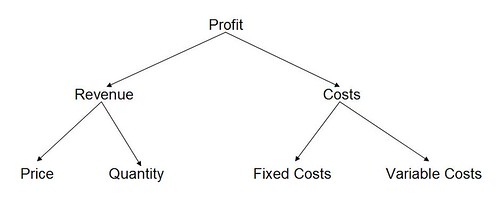In this very tough economic environment, organizations turn more and more focus on the Profit Tree. The course of history shows us that zeitgeist — or the movement of history at certain points of time — is a cascading phenomena where the collective focus and worldview is taken-on by large groups of people. At some point, business will need to Reconcile Culture and People with Revenue and Costs. Let me explain.
It seems that these days, we are all required to think more about the Profit Tree. But, are there other things to consider?
The Profit Tree
The model of the Profit Tree is a basic component of the free enterprise model. Below is the Profit Tree:

The model above is simple, but often not understood even by most business folks. To briefly explain, let’s use the following conventions:
- Î = Profit
- R = Revenue
- P = Price
- Q = Quantity
- C = Costs
- FC = Fixed Costs
- VC = Variable Costs
We know a few things from the model above:
- When R>C, then there is economic profit. This is what most companies want.
- When C>R, then the company is not profitable; most likely, the company is eating its free cash flow or using its credit line from its creditor.
- When R is flat and C continues to grow, that is typically when most companies seek help from folks with experience in fundamentally transforming a business operation — typically, these are folks with experience in Lean and in Six Sigma or Turnaround experience.
The principles above are required practice if a firm is to be financially viable. While the Profit Tree is important, there are other trees that need to be nurtured.
The Culture Tree
Most firms with any depth to it, will have a history and some values that it claims. These set of values will probably be codified into a document that explicates what is important to the company and these values dictate the behavior of the company employees. The collective behavior is what we typical call “culture“.
Lead by Example: To nurture the Culture of a company requires the leaders of the company to behave in accordance to its said values and to lead by example. This also includes hiring people that either already espouse the company values or can quickly and easily assimilate those values soon in the on-boarding process; similarly, firing those that don’t espouse and own those values in their behavior.
Speak the Culture: An integral part of a culture is the language used within a company and in its public messaging. It’s not just the words we use, but the stories we share with each other and with the public — stories that embody actual acts of culture — these stories carry organizational memory and last long after the people are gone.
Ritualize the Culture: I was once at a company where we had specific rituals or traditions that everybody practiced — it was taught, people did it willingly, and it embodied the values of the company. For example, prior to every meeting, this company always shared 3 things:
- Customer Success Story
- Safety Story
- Quality Story
The attendees of the meeting would volunteer to share the items above in a 3 minute segment. Because it was prior to a meeting, it set the tone for the meeting, especially since the first story was about the customer.
Since hundreds of meetings are held each day in a typical company, imagine how the tone is set daily about what is important to the company. Ritualizing the Culture can be powerful in mobilizing an entire company toward what is important.
Conclusion
The Profit Tree is not the only tree in the vineyard. In these economic times, the companies that nurture one tree more than another will realize that, when things are well and fine again — and they will be fine again, America — that some trees have gone uncared-for and might present a “win the battle but not the war” situation for most companies.
Take a balanced approach: grow economic profits and take care of the soft-stuff too, because the soft-stuff is truly the hard-stuff.
Become a Lean Six Sigma professional today!
Start your learning journey with Lean Six Sigma White Belt at NO COST






Patrick O'Shei says
After the cutting is done there is no choice but to sell your way to profitability and growth.
While a company has more control over the right side of the profit tree there is a real limit to the ability to reduce costs of all types. Price may be set in the abstract by the company but price times volume is set by the market of customers.
When the financial analysis is over, it becomes apparent that the true profit leverage comes from satisfying customer’s and their needs and giving them a reason to want to do business with you. The culture of the organization is the main deteriment in how a company treats its customer and responds to their needs.
Patrick O'Shei says
I meant to write “determinent”
ie. to determine.
Vinsensius Surjana says
somehow, somewhere, the chart should show an allocation for investment to obtain business growth. History teaches us that companies which do not “care” for business growth will ultimately break down i.e at the time the blockbuster product reaches natural decline, without any replacement product of the same trend the business will altogether decline.
Vinsensius Surjana says
some portion of the profit should be shared with the employees. Surveys world-wide regarding successful companies show that successful companies are those that shares its profit with the employees, I would even add, that shares its profit, in one way or another, with their customers, and those that could give input for the growth of the company.